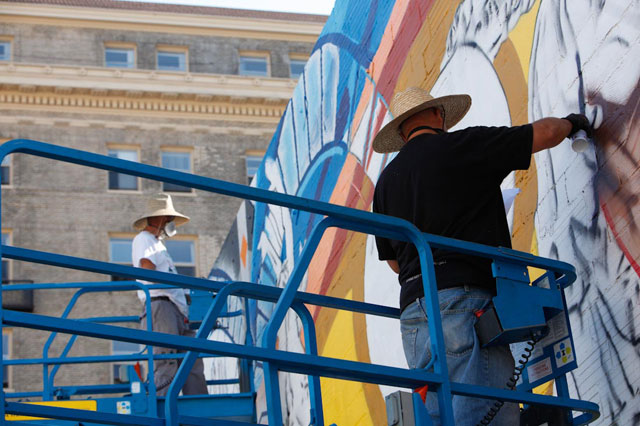Graffiti, street art, writers, aerosol art; no matter what you call it, painting on public walls can be controversial, commissioned or not. At its best, public art reflects the values and aspirations of the community that nourished it. At worst, the writing on the walls can be menacing, proof that those who care about the neighborhood may be fighting a losing battle. This powerful dichotomy is strongly felt in Oakland, a city covered with both beautiful murals and illegal tags.
I have always wondered, if murals are “for the community,” who decides what is shown? Who participates, and what is their process of creation? When I stumbled across a giant mural going up on 14th and Alice Streets in downtown Oakland, I knew I needed to learn more. I was taken by the beautiful colors, the personalities depicted, and also how many people were stopping to photograph the mural and talk with the artists. I’ve spent a long time in museums and galleries, so unexpectedly stumbling across such a lively piece was quite a joy for me. Seeing the community come out to watch the process unfold was exciting. I wrote down the artists’ names and began researching the project and their work later that night.

The main artists are Desi Mundo and Pancho Peskador, members of Oakland’s Community Rejuvenation Project (CRP), and they were working on the Alice Street Mural. CRP is a non-profit artist collective motivated by the belief that community-led murals can become fertile meeting grounds for communities.
CRP’s first wall went up in 2008. The group has since produced roughly 150 murals in the Bay Area, almost entirely in Oakland. Now, having worked street level with different neighborhoods all over Oakland, CRP has started what they call a “pavement to policy” initiative advocating for laws and use of public space to better serve the city’s communities. I sat down and spoke with several CRP members over lunch as they were taking a break from working on the mural.
Desi Mundo is the founder of CRP who avoids labels like “street” or “graffiti” artist, opting instead to call himself simply a writer. Originally from Hyde Park, Chicago, Mundo did his first legal wall in 1992, and has done countless more since. Growing up, Mundo loved how writing nourished a hyper-local sense of culture, place, and history, noting that every neighborhood in Chicago had its own distinct style. While Mundo is happy CRP is becoming more socially active, he notes that they still just love to paint. “There is a balance between when we work with the community, and sometimes when we just want to have fun.”

CRP Lead, Pancho Peskador is a trained fine artist from Santiago, Chile where he painted his first mural in high school of Pablo Neruda and other Chilean poets. Peskador came to Oakland in 1995 and was painting alone in his free time as much as possible, until he stumbled upon CRP. “I drove by while they were painting and stopped to talk. Whenever they went to paint I’d just show up.” Peskador writes, “Painting outside, in the street, open-air interaction with the people. After I felt that, it was hard to go back to the studio. I finally had what I was lacking for so long. That community aspect, that collective aspect, but also that interaction with people. Not needing to do a show to hear feedback about your work. So that’s how I started working with CRP.”

CRP believes that all art — especially mural art — reflects values and culture back to the community. Mundo believes in accepting that responsibility. Consequently, CRP has increasingly incorporated more community involvement into their work. Even though the Alice Street Mural only started going up on the wall recently, community outreach for the mural started over a year ago.






